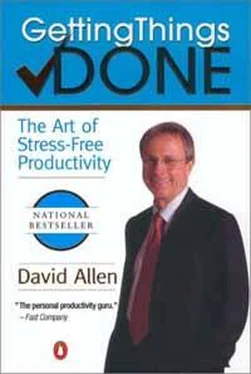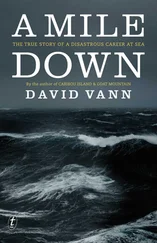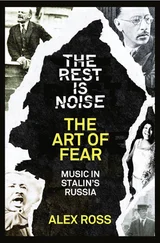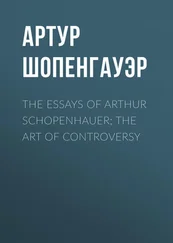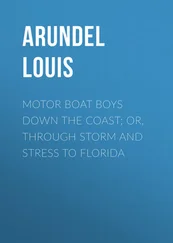Second, if there's something on a daily to-do list that doesn't absolutely have to get done that day, it will dilute the emphasis on the things that truly do. If I have to call Mioko on Friday because that's the only day I can reach her, but then I add five other, less-important or less time-sensitive calls to my to-do list, when the day gets crazy I may never call Mioko. My brain will have to take-back the reminder that that's the one phone call I won't get another chance at That's not utilizing the system appropriately. The way I look at it, the calendar should be sacred territory. If you write something there, it must get done that day or not at all. The only rewriting should be for changed appointments.
The "Next Actions" List(s)
So where do all your action reminders go? On "Next Actions" lists, which, along with the calendar, are at the heart of daily-action-management organization.-
Any longer-than-two-minute, nondelegatable action you have identified needs to be tracked somewhere. "Call Jim Smith re budget meeting," "Phone Rachel and Laura's moms about sleep away camp," and "Draft ideas re the annual sales conference" are all the kinds of action reminders that need to be kept in appropriate lists, or buckets, to be assessed as options for what we will do at any point in time.
If you have only twenty or thirty of these, it may be fine to keep them all on one list labeled "Next Actions," which you'll review whenever you have any free time. For most of us, however, the number is more likely to be fifty to 150. In that case it makes sense to subdivide your "Next Actions" list into categories, such as "Calls" to make when you're at a phone or "Project Head Questions" to be asked at your weekly briefing.
Nonactionable Items
You need well-organized, discrete systems to handle the items that require no action as well as the ones that do. No-action systems fall into three categories: trash, incubation, and reference.
Trash
Trash should be self-evident. Throw away anything that has no potential future action or reference value. If you leave this stuff mixed in with other categories, it will seriously undermine the system.
Incubation
There are two other groups of things besides trash that require no immediate action, but this stuff you will want to keep. Here again,it's critical that you separate nonactionable from actionable items;otherwise you will tend to go numb to your piles, stacks, and lists and not know where to start or what needs to be done.
Say you pick up something from a memo, or read an e-mail, that gives you an idea for a project you might want to do someday, but not now. You'll want to be reminded of it again later so you can reassess the option of doing something about it in the future. For example, a brochure arrives in the mail for the upcoming sea-son of your local symphony. On a quick browse, you see that the program that really interests you is still four months away—too distant for you to move on it yet (you're not sure what your travel schedule will be that far out), but if you are in town, you'd like to go. What should you do about that?
There are two kinds of "incubate" systems that could work for this kind of thing: "Someday/Maybe" lists and a "tickler" file.
"Someday/Maybe" It can be useful and inspiring to maintain an ongoing list of things you might want to do at some point but not now. This is the "parking lot" for projects that would be impossible to move on at present but that you don't want to forget about entirely. You'd like to be reminded of the possibility at regular intervals.
Typical Partial "Someday/Maybe" List
Get a bass-fishing boat
Learn Spanish
Take a watercolor class
Get a sideboard for the kitchen
Build a lap pool
Get Kathryn a scooter
Take a balloon ride
Build a wine cellar
Take a trip through Montana
Learn Photoshop software capabilities
Set up a not-for-profit foundation
Create promotional videos of staff
Find Stafford Lyons
Get a digital video camera*
Northern Italy trip
Apprentice with my carpenter
Spotlight our artwork
Build a koi pond
Digitize old photos and videos
Have a neighborhood party
Set up remote-server access at home
You'll probably have some subcategories in your master "Someday/Maybe" list, such as
• CDs I might want
• Videos to rent
• Books to read
• Wine to taste
• Weekend trips to take
• Things to do with the kids
• Seminars to take
You must review this list periodically if you're going to get the most value from it. I suggest you include a scan of the con-tents in your Weekly Review (see page 46).
"Tickler" File The most elegant version of holding for review is the "tickler" file, sometimes also referred to as a "suspended" or "follow-on" file. This is a system that allows you to almost literally mail something to yourself, for receipt on some designated day in the future.
Your calendar can serve the same function. You might remind yourself on your calendar for March 15, for example, that your taxes are due in a month; or for September 12, that Swan Lake will be presented by the Bolshoi at the Civic Auditorium in six weeks.
For further details, refer to chapter 7.
Reference Material
Many things that come your way require no action but have intrinsic value as information. You will want to keep and be able to retrieve these as needed. They can be stored in paper-based or digital form.
Paper-based material—anything from the menu for a local take-out deli to the plans, drawings, and vendor information for a landscape project—is best stored in efficient physical-retrieval systems. These can range from pages in a loose-leaf planner or notebook, for a list of favorite restaurants or the phone numbers of the members of a school committee, to whole file cabinets dedicated to the due-diligence paperwork for a corporate merger.
Electronic storage can include everything from networked database information to ad hoc reference and archive folders located in your communication software.
The most important thing to remember here is that reference should be exactly that—information that can be easily referred to when required. Reference systems generally take two forms: (1) topic-and area-specific storage, and (2) general-reference files. The first types usually define themselves in terms of how they are stored—for example, a file drawer dedicated to contracts, by date; a drawer containing only confidential employee-compensation information; or a series of cabinets for closed legal cases that might need to be consulted during future trials.
General-Reference Filing The second type of reference system is one that everyone needs close at hand for storing ad hoc information that doesn't belong in some predesignated category. You need somewhere to keep the instruction manual for your cell phone, the notes from the meeting about the Smith project, and those few yen that you didn't get to change at the end of your last trip to Tokyo (and that you'll use when you go back there).
The lack of a good general-reference file can be one of the biggest bottlenecks in implementing an efficient personal action-management system. If filing isn't easy and fast (and even fun!), you'll tend to stack things instead of filing them. If your reference material doesn't have a nice clean edge to it, the line between actionable and nonactionable items will blur, visually and psycho-logically, and your mind will go numb to the whole business. Establishing a good working system for this category of material is critical to ensuring stress-free productivity; we will explore it in detail in chapter 7.
Читать дальше
